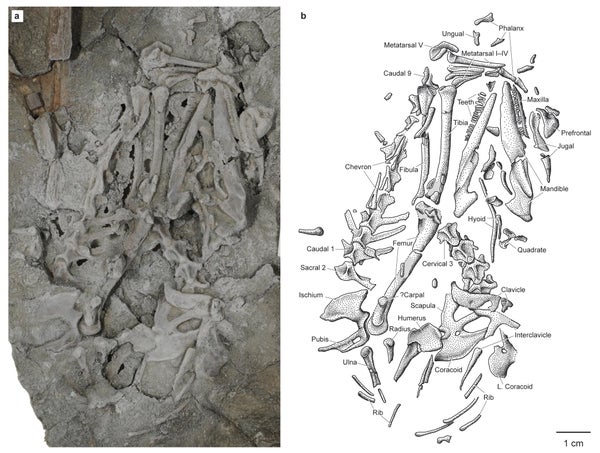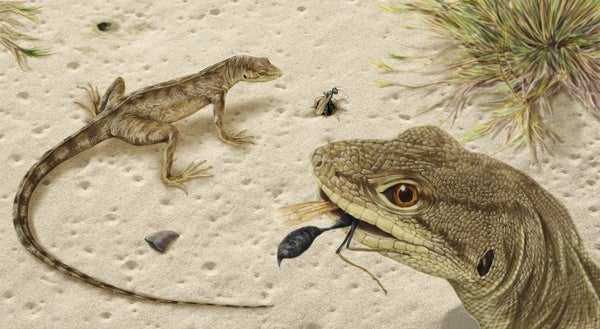This article was published in Scientific American’s former blog network and reflects the views of the author, not necessarily those of Scientific American
The Mesozoic is often called the Age of Reptiles. The term isn't so much about the most significant or prolific form of life on Earth - as Stephen Jay Gould once pointed out, our planet has always been in the Age of Bacteria - as much as it underscores what we think of as important when we look into the past.
As far as the span of Triassic, Jurassic, and Cretaceous goes, the stars have always been the non-avian dinosaurs and other weirdos like the plesiosaurs, pterosaurs, and mosasaurs, but we'd be sorely remiss if we neglected the other reptilian inhabitants of this past time. Not every saurian in the Age of Reptiles was bizarre or enormous, like a new species of lizard just described by paleontologists this week.
Just like the Age of Reptiles itself, Egg Mountain became famous for its connection with dinosaurs. This was a vast nesting ground for the hadrosaur Maiasaura. But this boneyard has also yielded much smaller, more delicate fossils, including a pair of small, nearly-complete lizard skeletons. These two fossils, paleontologist David DeMar and colleagues report, represent a new species dubbed Magnuviator ovimonsensis.
In the many-branched tree of lizard evolution, Magnuviator comes out as an iguanomorph. This is the broad group that includes the anoles, basilisks, and iguanas that skitter around the American tropics today. But back in Cretaceous time, DeMar and coauthors write, the closest relatives of Magnuviator lived in Asia. The fossil stem from which today's iguanas and anoles sprung used to be spread in a different pattern over the planet, setting part of the foundation for what we see around us today.
But Magnuviator is also a reminder of something else. Dinosaurs and other large Mesozoic creatures dominate our attention. We're obsessed with the biggest and the weirdest. But we still know relatively little about the smaller inhabitants of that time. The lizards, snakes, mammals, and even tiny dinosaurs who lived during the Age of Reptiles are only just starting to come into focus. If you want to search the Mesozoic frontier, think small.

One skeleton of Magnuviator. Credit: David DeMar and Morgan Turner
On supporting science journalism
If you're enjoying this article, consider supporting our award-winning journalism by subscribing. By purchasing a subscription you are helping to ensure the future of impactful stories about the discoveries and ideas shaping our world today.
Fossil Facts
Name: Magnuviator ovimonsensis
Meaning: Mighty traveler from Egg Mountain.
Age: Cretaceous, 75 million years ago.
Where in the world?: Montana, United States.
What sort of critter?: A lizard related to today's anoles and iguanas.
Size: About 14 inches long.
How much of the organism’s body is known?: Two nearly-complete skeletons.
Reference:
DeMar, D., Conrad, J., Head, J., Varricchio, D., Wilson, G. 2017. A new Late Cretaceous iguanomorph from North America and the origin of New World Pleurodonta (Squamata, Iguania). Proceedings of the Royal Society B. doi: 10.1098/rspb.2016.1902
Previous Paleo Profiles:
The Light-Footed Lizard The Maoming Cat Knight’s Egyptian Bat The La Luna Snake The Rio do Rasto Tooth Bob Weir's Otter Egypt's Canine Beast The Vastan Mine Tapir Pangu's Wing The Dawn Megamouth The Genga Lizard The Micro Lion The Mystery Titanosaur The Echo Hunter The Lo Hueco Titan The Three-Branched Cicada The Monster of Minden The Pig-Footed Bandicoot Hayden's Rattlesnake Demon The Evasive Ostrich Seer The Paradoxical Mega Shark The Tiny Beardogs The Armored Fish King North America's Pangolin The Invisible-Tusked Elephant The Mud Dragon The Spike-Toothed Salmon The Dream Coast Crocodile Buriol's Robber Ozimek's Flyer The Northern Naustoceratopsian The High Arctic Flyer The Tomatillo From the End of the World The Short-Faced Hyena
